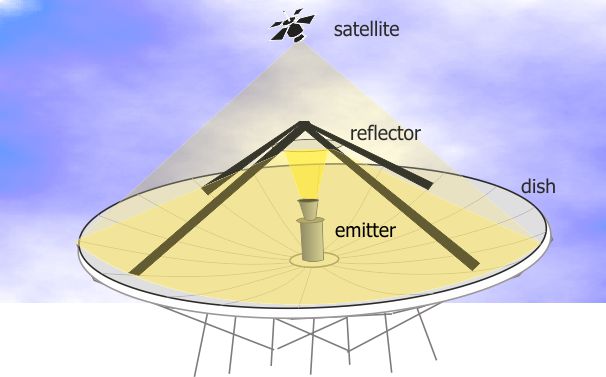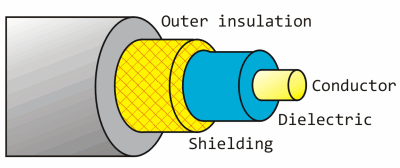Freesat reception - all about dishes
 Brian Butterworth published on UK Free TV
Brian Butterworth published on UK Free TV Satellite reception has both advantages and disadvantages compare with terrestrial (aerial) reception.
By using much higher frequencies (gigahertz, compared to terrestrial televisions megahertz) more transmission channels called transponders (the satellite equivalent of multiplexes) can be provided. For example, there are only six Freeview multiplexes, but Sky or Freesat users can access two hundred satellite transponders.
Aside from exceptional weather conditions (very heavy rain for example) digital satellite provides stable pictures and audio. Where Freeview transmitters are no more than 732 metres above sea level, the geostationary satellites used for television are 35,800,000 metres above the equator so reception is possible even where buildings, trees and hills make terrestrial reception impossible.

The downside of the transmitters being 22,300 miles up in the air is that the signals are very, very weak - so standard TV aerial is of little use. When the signals are sent to the satellites, huge dish transmitters are used to uplink the signal to the satellite. These are tens of metres from side to side, and feature an emitter that generates the signal, which is first bounced of a mirror (called a reflector) and then off the surface of the parabolic dish.

There are many satellites in the sky over the equator. Often these are in clusters over a particular position, for example there are four used for UK television are at 28.2 degrees east. There is another cluster over the 19.2 degrees east positions that are used for German television.
To receive these very weak signals from the satellite, it is necessary to use a dish for reception too. By using a reflective dish, this concentrates the signals onto a small device called a LNB. This is held in front of the dish by a metal arm.

The size of dish for reception is typically much smaller; often 60cm to 100cm in diameter, but the exact size depends upon the transmitting satellite transponder. To keep the transmission power levels down to levels that can be powered by the satellite's solar panels, each beam is focused on a particular area of the Earth's surface. If you are trying to receive the signal at the centre of this zone, a small dish is required. At the outer edges, you may need a 5 metre dish. Maps of these zones are provided by the satellite companies, and are called satellite footprints.
When the dish is installed it must be aligned carefully as the signal is very weak. The installer needs to know the inclination and the azimuth from the ground location to the satellite. If you install yourself you will find that there are markings on the dish that are used to point the dish in the correct position. It is important that the view of the satellite will not be blocked, so must take into account leaves growing on trees and potential building works.
For many people the LNB will have a single cable connected to it, however if you have Sky+ or a multi-room installation the LNB package will actually contain four receivers a quad-LNB. Unlike terrestrial television where you can split the aerial cable to feed more than one Freeview box or television set, with satelite reception you cannot. So, a Sky+ box with two receivers (so you can watch one thing and record another) has two cables connecting the box to the dish.
The cable that connects the dish to the receiver must be satellite grade cable. Whilst this looks superficially like the cable used to connect and aerial to a television, a higher grade cable is required for satellite reception.
Here is an image of a co-axial cable. This sort of cable is used to connect any type of receiving aerial to the reception equipment.

RG6, PF100 and PH100 are all types of coax cable that are suitable for the very weak signals that are received by a satellite dish. (The power is the same as you would receive from a one-bar electric heater on the moon).
The conductor in the centre passes the signals received from the dish to the set-top box. This is made from steel in RG6 cable, and from copper in the RF100 and PH100 types. This makes RG6 less suitable in the UK where rain can damage the cable.
The shielding is responsible for keeping unwanted external interference from damaging the signal. In the cheaper cable this will be a foil wrap, in better specified cables this is a braid (or mesh) of copper wires. The sheild in the RF100 covers 58% of the cable.
The non-conducting layer between the shield and the conductor is called the dielectric. This can be either a solid (RG6), foam (RF100) or air-spaced (PH100) dielectric. This makes the cables progressively more flexible (ie bendy without damage).
4:06 PM
When well we have all the channels that freebies has
| link to this comment |
6:43 PM
Barnsley
Kevin Staley.Hard to say without a full postcode or nearby location as such,but if you reside in an area served only by a Freeview lite relay mast,the answer is no.
| link to this comment |
Mark's: mapM's Freeview map terrainM's terrain plot wavesM's frequency data M's Freeview Detailed Coverage
10:35 AM
Dear Guru,
My brand new HD TV suffers picture drop-out on terrestrial Freeview (only on HD). Even though I have line-of-sight to Crystal Palace, its been suggested that a less compressed satellite signal might overcome the issue. The TV accepts a direct satellite input, so I would like to purchase and fit my own dish. Can you briefly describe the ease (or not) of the alignment procedure and also the equipment required to align? Also, I understand that high quality German, French, Swiss radio (music) is available via satellite. Would these signals come from a separate satellite (which please?) and if so, would an additional LNB pick-up be required? Hows it done?
Thanks
| link to this comment |
4:06 PM
Colchester
I'm wondering if anyone can give me an idea of the likely cost of running a dual cable from my Sky dish into a bedroom in order to fit a Freesat PVR? The dish is situated on the wall of the room concerned.
Many thanks.
| link to this comment |
Susan's: mapS's Freeview map terrainS's terrain plot wavesS's frequency data S's Freeview Detailed Coverage
8:15 PM
Hi; should the LNB on my fresat dish, wobble about, my TV keeps telling me no signal avalible, and my tv go's to standby mode , this was fited by an exspert and is jusr out of warenty. I'v bourt a new top box but it's made no diffrancs what should i do next. all the best BOB.
| link to this comment |
8:35 PM
R A YOUNG: No it shouldnt! and if the dish arm is of the round type then it suggests that the 40mm collar around the LNB has either slackened off or has even snapped, or if its a Sky elliptical dish with a rectangular arm, that where the LNB fixes to the short spigot mounting arm has come adrift.
No matter what type though, new LNB's inc fixing kits can be obtained for just over £10.00 or so from numerous e-bay sources.
| link to this comment |
12:17 PM
Hi,Im from Sri Lanka. I bought a satellite receiver and Dish. I want to see FTA Channels. pls tell me the satellite name which i want to select.
| link to this comment |
10:42 PM
i have just move in my house which has a dish.
But, to the dish, only one cable line is connected.
is it poaaible to watch presat channel?
how to do?
| link to this comment |
11:20 PM
J. kim: You do not require two leads from the dish unless you are using a Sky+ box or a Freesat twin tuner recorder.
An ordinary Sky box or a Freesat box only requires one lead, as technically they are exactly the same as far as the dish is concerned.
| link to this comment |